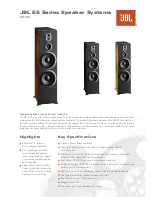
3
YOUR NEW SPEAKERS
Break-In
Although your speakers will sound great ‘out of the carton’, they will sound even better once they are
‘broken in.’ Allow them to play for several hours before you begin to listen critically.
Drivers use ferro-fluid that can thicken at temperatures below 10° C (50° F). Surround material used
in the bass/midrange units is made of a compound that may stiffen in colder temperatures. If your
speakers have been transported or stored in the cold, let them warm to room temperature before use.
Cleaning
Your speakers have a premium finish that must be treated with care. Use only a damp, soft cloth to
clean. Never use strong, abrasive or corrosive cleaning products. Common household cleaning
products should be avoided.
Speaker Grilles
Your speakers are meant to be played with their grilles on.
HOW TO AVOID SPEAKER DAMAGE
Your speakers are efficient and can be driven to loud listening levels with moderate amplifier power.
They are also able to handle the output of very powerful amplifiers. To prevent damage to your
speakers, please read the following guidelines before hooking them up.
Amplifier Distortion — The #1 Culprit!
Amplifier distortion is the principle cause of speaker damage. When listening at higher volume
levels, your amplifier may run out of clean power and begin to produce a distorted signal if
levels are increased any further. This will damage any brand of speaker very quickly. (See your
Authorized Paradigm Dealer for amplifier recommendations).
More Powerful Amplifiers are Safer
When choosing an amplifier, always select an amplifier with a power rating greater than that of
the speaker. Using a 100 watt per channel amplifier on a 50 watt speaker allows the amplifier
adequate headroom in order to provide a distortion free signal. Conversely, using a 40 watt per
channel amplifier on a 50 watt speaker limits the amplifier’s headroom. This causes the amplifier
to enter its distortion level much sooner, potentially damaging the speaker.
Volume Control
Do not be fooled by the Volume Control of your receiver/preamplifier. It only adjusts listening
level—it is not a “power-output” dial. The amount of amplifier power actually used at a given
Volume Control setting depends solely on the nature of the music you are listening to.
At a given Volume Control setting a quiet section of music will use less amplifier power than a loud
section. With typical pop-rock, jazz or large scale classical music, the rated output power of many
receivers/amplifiers is often reached when the Volume Control is between the ‘11 and 1 o’clock’
settings (with bass/treble and loudness controls not used—otherwise rated power may be reached
at even lower Volume Control settings).
Remember, all amplifiers produce distortion when operated beyond their rated output power. The
resulting distortion will damage all speakers! Exercise caution! If you listen at loud levels, be careful
to listen for the point of audible distortion—if the speakers begin to sound distressed turn the
Volume Control down or your speakers and/or amplifier(s) will be damaged!
This type of damage
constitutes abuse and is not covered by the warranty.
If louder volumes are desired, obtain a more
powerful amplifier.
Summary of Contents for Decor 2SC
Page 1: ...OWNERS MANUAL...
Page 10: ...MODE D EMPLOI...




































